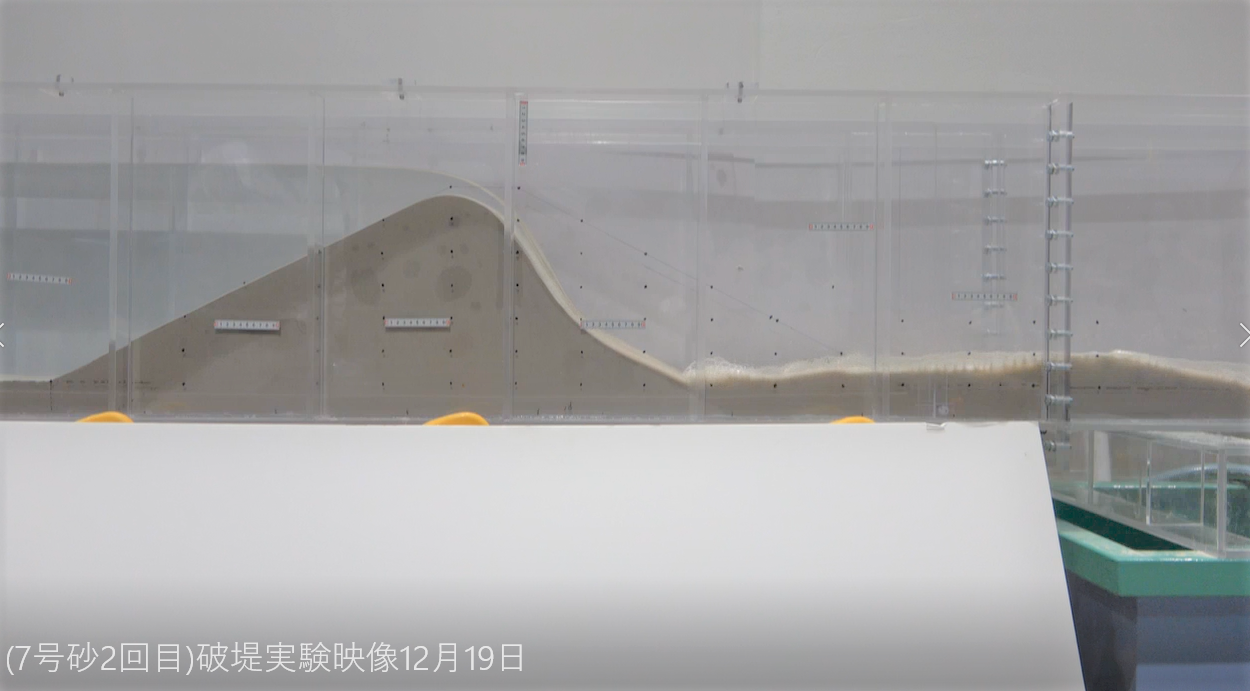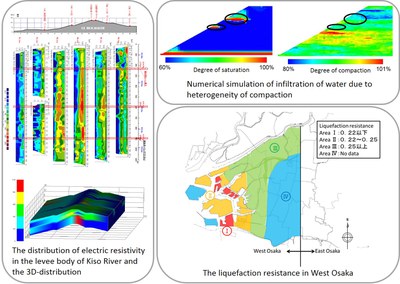1. Modeling Behaviors of Geomaterials from Micro to Macro
Geomaterials behaviors can be interpreted as rearrangement of structures composed of particles, pore water, and pore air. We are investigating microscopic structural changes and multiphase interactions and their links to meso- and macro-behaviors of geomaterials using x-ray microtomography and image analysis technique.

Related Publications
- Kido, R. and Higo, Y. (2020), Microscopic characteristics of partially saturated dense sand and their link to macroscopic responses under triaxial compression conditions, Acta Geotechnica, Published
Online: August 05, 2020. https://doi.org/10.1007/s11440-020-01049-w - Kido, R., Higo, Y., Takamura, F., Morishita, R., Khaddour, G. and Salager, S. (2020), Morphological transitions for pare water and pore air during drying and wetting processes in partially saturated
sand, Acta Geotechnica, published online (19 February 2020), https://doi.org/10.1007/s11440-020-00939-3. - Higo, Y., Kido, R., Takamura, F. and Fukushima, Y. (2018), Pore-scale investigations of partially water-saturated granular soil, Mechanics Research Communications, Vol.94, pp.1-7.
https://doi.org/10.1016/j.mechrescom.2018.08.016 - ⽊⼾隆之祐,肥後陽介,⾼村福志 (2017),三軸圧縮下の不飽和砂の進⾏的なせん断帯発達過程における間隙⽔の微視的特性,⼟⽊学会論⽂集C(地圏⼯学),Vol.73,No.2,pp.233-247.
https://doi.org/10.2208/jscejge.73.233 - Higo, Y., Oka, F., Morishita, R., Matsushima, Y. and Yoshida, T. (2014), Trinarization of μX-ray CT images of partially saturated sand at different water-retention states using a region growing
method, Nuclear Instruments and Methods in Physics Research Section B: Beam Interactions with Materials and Atoms, 324(1), pp.63-69, 2014. https://doi.org/10.1016/j.nimb.2013.11.024 - Higo, Y., Oka, F., Sato, T., Matsushima, Y. and Kimoto, S. (2013), Investigation of localized deformation in partially saturated sand under triaxial compression by microfocus X-ray CT with
digital image correlation, Soils & Foundations, 53(2), pp.181-198. https://doi.org/10.1016/j.sandf.2013.02.001 - Higo, Y., Oka, F., Kimoto, S., Sanagawa, T. and Matsushima, Y. (2011), Study of strain localization and microstructural changes in partially saturated sand during triaxial tests using microfocus X-ray
CT, Soils & Foundations, 51(1), pp.95-111. https://doi.org/10.3208/sandf.51.95
For modeling geomaterial behaviors, a constitutive model to describe deformation and failure characteristics is important. We are developing reasonable constitutive models based on experimental facts obtained micro, meso and macro scales.
Related Publications
- Oka, F., Kimoto, S., Higo, Y., Ohta, H., Sanagawa, T. and Kodaka T. (2011), An elasto-viscoplastic model for diatomaceous mudstone and a numerical simulation of compaction bands, Int. J. Numerical and Analytical Methods in Geomechanics, 35, pp. 244-263. Article first published online: 10 NOV 2010 DOI: 10.1002/nag.987 in Wiley Online Library.
- Higo, Y., Oka, F., Kodaka, T., and Kimoto, S. (2006), Three dimensional strain localization of watersaturated clay and numerical simulation using an elasto-viscoplastic model, Philosophical Magazine, Structure and Properties of Condensed Matter, 86, 21-22, pp.3205-3240. https://doi.org/10.1080/14786430500321203
- Higo, Y., Oka, F., Jiang, M.J., and Fujita, Y. (2005), Effects of transport of pore water and material heterogeneity on strain localization of fluid-saturated gradient-dependent viscoplastic geomaterial,
International Journal for Numerical and Analytical Methods in Geomechanics, 29, 495-523. https://onlinelibrary.wiley.com/doi/abs/10.1002/nag.423
For evaluation and prediction of behaviors of real-scale earth structures such as river levees and road embankments, we are developing numerical simulation methods using the constitutive models. Material Point Method has been newly developed to simulate extremely large deformation. In addition, model tests using geotechnical centrifuge (DPRI, Kyoto University) have conducted for physical modeling of macro behaviors.
Related Publications
- Higo, Y., Oka, F., Kimoto, S., Morinaka, Y., Goto, Y. and Chen, Z. (2010), A coupled MPM-FDM analysis method for multi-phase elasto-plastic soils, Soils & Foundations, 50(4), pp.515-532.
https://doi.org/10.3208/sandf.50.515 - Higo, Y., Lee, C.-W., Doi, T., Kinugawa, T., Kimura, M., Kimoto, S. and Oka, F. (2015), Study of dynamic stability of unsaturated embankments with different water contents by centrifugal model
tests, Soils and Foundations, 55(1), pp.112-126, DOI information: 10.1016/j.sandf.2014.12.009 - 桐⼭貴俊,肥後陽介 (2016),計算格⼦を利⽤した領域積分数値計算法の地盤⼤変形問題への適⽤,⼟⽊学会論⽂集A-2, Vol. 72, No. 2, p. I_155-I_165.https://doi.org/10.2208/jscejam.72.I_155
2. Designing “robustness” of earth structures
It is important for earth structures to have “robustness” to avoid catastrophic damage against accidental natural hazards such as large earthquakes and floods caused by heavy rainfalls. We are developing a numerical method that accurately describes the progressive failure of river levees during earthquakes and overtopping flows such as surface erosion and liquefaction-induced large deformation. Then, alternative models for these simulation methods based on reliability analysis theory are developed and applied to establish a design scheme of “robust” earth structures.

Erosion of river levee caused by overtopping flow (model test, by courtesy of Dr. Onda, KU)

Liquefaction-induced large deformation simulated using Material Point Method
Related Publications
- ⼤⽵雄,茂野恭平,渡邉慎也,肥後陽介,村松正吾 (2020),モード分解を⽤いた時空間の特徴抽出に基づくデータ駆動型・動的信頼性解析法︓有効応⼒動的解析への適⽤,⼟⽊学会論⽂集 C(地圏⼯学), Vol.76,
No.2, pp.142-157, https://doi.org/10.2208/jscejge.76.2_142. - 肥後陽介,⾳⽥慎⼀郎,⾼野⼤樹,⼭内敏貴 (2018),表⾯流による⼟のせん断破壊挙動としての表⾯侵⾷の解釈,⼟⽊学会論⽂集B1(⽔⼯学),Vol.74, No.5, pp. I_901- I_906,
https://doi.org/10.2208/jscejhe.74.5_I_901. - Higo, Y., Nishimura, D. and Oka, F. (2014), Dynamic analysis of unsaturated embankment considering the seepage flow by a GIMP-FDM coupled method, Computer Methods and Recent Advances in Geomechanics – Proceedings of the 14th Int. Conference of International Association for Computer Methods and Recent Advances in Geomechanics, IACMAG 2014, Oka, F., Murakami, A., Uzuoka, R. and Kimoto S. eds., September 22-25 2014, Kyoto, Japan, pp.1761-1766.
3. Modeling and Visualization of Underground Structures and Application to Disaster Assessment
It is usually difficult to observe ground except for the surface, although the deformation and failure of the ground are closely related to the underground structures. We have been studying geophysical explorations that enable visualization of wide-area underground structures and DModeling and Visualization of Underground Structures and Application to Disaster Assessment modeling of the ground using boring database. The underground structures provided by these observations contribute to the numerical analysis and micro zoning for disaster assessment such as evaluation of rainfall infiltration into earth structures and liquefaction mapping.

Related Publications
- 肥後陽介,南野佑貴,加藤亮輔,⽚岡沙都紀,甲斐誠⼠ (2016),道路盛⼟内の宙⽔の原位置調査および再現解析,Kansai Geo-Symposium 2016-地下⽔地盤環境・防災・計測技術に関するシンポジウム-,pp.183-188.
- 南野佑貴,肥後陽介,⼤⽵雄,加藤亮輔,吉村貢 (2016),不飽和盛⼟内宙⽔の発⽣要因についての数値解析的研究,Kansai Geo-Symposium 2016-地下⽔地盤環境・防災・計測技術に関するシンポジウム-,pp.189-194.
- 深⽥⻯司,肥後陽介,⼤⽵雄,南野佑貴,加藤亮輔 (2017),盛⼟内の不均質透⽔性空間分布の⽣成と不飽和降⾬浸透解析への適⽤,⼟⽊学会論⽂集A2(応⽤⼒学),Vol.73,No.2,p. I_791-I_799. https://doi.org/10.2208/jscejam.73.I_791